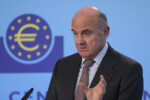FMW-Redaktion
Die EZB hat soeben das Protokoll ihrer Sitzung vom 7. September veröffentlicht. Dazu präsentieren wir hier auszugsweise Originaltexte der EZB mit unseren Kommentaren.
Laut der EZB brummt die Wirtschaft in der Eurozone. Man zeige sich besorgt über die Geschwindigkeit des ansteigenden Euros (schlecht für Exporte), aber die Wirtschaft wachse so stark, dass dieses Problem damit ausgeglichen werde. Zitat EZB:
With regard to the economic analysis, members broadly agreed with the assessment of the outlook and risks for economic activity in the euro area provided by Mr Praet in his introduction. According to recent data and survey indicators, the economic expansion had continued to be solid and broad-based across countries and sectors, but had accelerated more than expected in the first half of 2017. Looking ahead, economic growth was expected to remain robust, with stronger domestic demand expected to offset the impact of the appreciation of the euro on exports. This assessment was reflected in the outlook for growth contained in the September 2017 ECB staff projections. Compared with the June 2017 Eurosystem staff projections, the outlook for real GDP growth had been revised up for 2017, reflecting the recent stronger growth momentum, and was broadly unchanged for 2018 and 2019.
Die Inflation wachse zwar „dank der EZB-Maßnahmen“, bleibe aber immer noch zu schwach, als das man die Zinswende einleiten könnte. Zitat:
In discussing the outlook for inflation included in the September staff projections, concern was again voiced about the possibility of changes in the inflation process that might lead to low inflation rates being more persistent, including the role of changes in inflation expectations and wage indexation practices. Commenting on measures of underlying inflation, members agreed that there were not yet convincing signs of a sustained convergence towards levels compatible with the ECB’s inflation aim. At the same time, a number of measures of underlying inflation had increased moderately compared with the second half of 2016. HICP inflation excluding food and energy, for example, had risen to 1.2% in August this year, from around 0.8% a year earlier. This pointed to tentative signs of reflationary forces slowly taking hold as the economic expansion gathered pace. It was argued that there was little doubt about the direction but more uncertainty about the pace of underlying inflation. In considering labour cost pressures in the latest staff projections, it was noted that wage developments had remained subdued, with annual growth in compensation per employee declining from 1.4% in the fourth quarter of 2016 to 1.2% in the first quarter of 2017.
Die EZB bleibt bei ihrer Sicht der Dinge. Die Wirtschaft in der Eurozne wächst robust und total super, aber die Inflation wachse immer noch zu schwach. So ein Pech auch… Zitat:
With regard to the monetary policy stance, members widely shared the assessment provided by Mr Praet in his introduction that the available information overall confirmed a broadly unchanged medium-term outlook for euro area economic growth and inflation, as also entailed in the September 2017 ECB staff projections. While the economic expansion continued to be solid and broad-based across countries and sectors, inflation dynamics remained subdued and signs of progress towards a sustained adjustment in the path of inflation were generally judged to still be insufficient. At the same time, there were grounds for confidence that inflation would gradually converge to levels in line with the Governing Council’s aim of inflation below, but close to, 2%.
Die Politik der EZB solle hoch anpassungsfähig sein, damit man bei schnellen Veränderungen der Daten auch zügig reagieren könne. Zitat:
In this context, a view was reiterated that, looking ahead, the Governing Council needed to regain more policy space and flexibility to adjust policy and the degree of monetary policy accommodation in either direction, if and when needed, to cope with a maturing business cycle and potential future shocks.
Aus verschiedenen Teilen der sehr langen Veröffentlichung der EZB haben wir die folgenden Teile herausgepickt, die uns als zentral wichtig erscheinen. Die EZB meint, dass es weiterhin einer umfangreichen geldpolitischen Maßnahme bedarf um die Inflation Richtung 2% zu bekommen. Die EZB-Offiziellen seien einig darin, dass die eigene Geldpolitik beharrlich und bedächtig sein müsse. Man habe verschiedene Szenarien besprochen, was man mit dem Anleihekaufprogramm für Staatsanleihen (PSPP) machen werde. Allgemein geht man davon aus, dass die EZB im Oktober konkret sagen wird, wie man das Programm allmählich reduziert. Im September-Statement hat man sich erstmal noch alle Optionen offen gehalten durch eine allgemeine und unverbindliche Formulierung.
At the same time, it was underlined that a very substantial degree of monetary policy accommodation was still needed for inflation to converge sustainably to levels in line with the Governing Council’s aim.
Members also discussed some general trade-offs inherent in various scenarios for the future recalibration of the APP and, in particular, the choice between the pace and the intended duration. Within the framework of the Governing Council’s forward guidance, the benefits from a longer intended purchase horizon, combined with a greater reduction in the pace, were compared with those from a shorter period of purchases and larger monthly volumes. In this context, the point was again made that both the costs and benefits of extending APP purchases, including possible financial stability risks, needed to be taken into account.
There was broad agreement to emphasise, as on previous occasions, the need for monetary policy to remain persistent and patient. A very substantial degree of monetary accommodation was still necessary for inflation pressures to build up.
Fazit: Es ist möglich, dass die EZB im Oktober verkündet das Aneleihekaufprogramm in 2018 fortzusetzen, oder einen stufenweisen vorsichtigen Ausstieg vorzubereiten Da lässt man alle Optionen offen. Bei den Zinsen aber, das wird mal wieder klar, ist ein Änderung der Politik der EZB (Zinsanhebung) immer noch in weiter Ferne.
Der Euro hat sich seit der Veröffentlichung des Textes gegen den US-Dollar um ganze 7 Pips nach unten bewegt. Also: Die EZB verschiebt mögliche interessante Infos auf die nächste Sitzung.

Das EZB-Logo. Grafik: EZB / Gemeinfrei
Kommentare lesen und schreiben, hier klicken













Nowotny: Kurswechsel Anfang 2018.
http://www.teleboerse.de/Der_Boersentag/Donnerstag-5-Oktober-2017-article20066933.html
Die Politik der EZB solle hoch anpassungsfähig sein, damit man bei schnellen Veränderungen der Daten auch zügig reagieren könne.
Guter Witz, eher lernen Schweine fliegen. Für eine hoch anpassungsfähige Politik braucht es hoch flexible Politiker bzw. in dem Fall EZB-Fürsten. Und die mögen vieles sein, aber anpassungsfähig?
Wieso beharrt man dann so starr und unflexibel auf diesen dubiosen 2%?
Wie soll man zügig reagieren können, wenn der Zinssatz nach unten praktisch ausgereizt ist? Wenn es nichts mehr gibt, was die großen Meister noch aufkaufen können?
Bleibt zu befürchten, dass die EZB denselben Fehler begeht, wie das amerikanische Pendant: Jahrelang keine Reaktion auf eine brummende, stetig steigende Wirtschaft, wenn irgendwann alles zu überhitzen beginnt, erwägt man vielleicht einmal erste kleine Schrittchen, wenn dann die Stagnation und die Rezession da ist, reagiert man, leider deutlich zu spät.